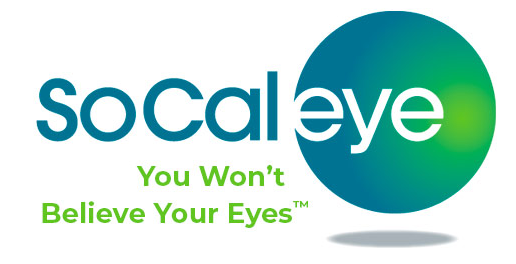Statistically more than 90 percent of people in the United States over the age of 65 will develop cataracts. The condition is most closely related to aging and can be easily corrected with Cataract Surgery which is now one of the most common surgical procedures performed every year. The Cataract Eye Doctors at SoCal Eye have been performing this life changing surgery in Long Beach for over 50 years.
Age and Cataracts:
If you live long enough, you will eventually develop cataracts. As you grow older, the natural lens in your eye will sooner or later become cloudy and opaque, interfering with your vision. Looking through a cataract is similar to looking through a dirty window – objects appear blurry and faded, along with other symptoms depending on the specific type of cataract you have. When you’re young, the lens in your eye is clear.
At What Age to Cataracts Develop?
Around age 40, the proteins in the lens of your eye start to break down and clump together. This clump makes a cloudy area on your lens — or a cataract. Over time, the cataract gets more severe and clouds more of the lens. They usually do not start to form until you are in your 60s. In fact, some people do not develop cataracts until they are well into their 80s. However, they can develop at a much younger age.
At first, cataracts may not interfere much with your daily life activities. However, they can eventually lead to blindness if left untreated. Once cataracts affect your vision enough that they impact your quality of life, it is time to think about treatment. Cataract surgery is a fast and painless procedure with an extremely high success rate. Your clouded natural lens will be replaced with a lens implant to provide you with clear, unhindered vision again.
Other Causes of Cataracts:
Aging is not the only reason a cataract may form. Several other reasons why a cataract may form include:
Traumatic Cataract – Eye Trauma is another common cause of cataracts: blunt or penetrating ocular trauma, electric shock, chemical burns, or ionizing radiation. A traumatic cataract can develop even years after these types of eye injuries.
Diabetes – People with diabetes are 60% more likely to develop cataracts. The aqueous humor provides nutrients to our eye’s lens, including oxygen and glucose. A person who suffers from diabetes will not have full control of their glucose levels which may result in high levels of sugar in the aqueous humor. This can lead to swelling, simultaneously affecting vision. Likewise, the lens inside the eye has an enzyme that converts glucose into sorbitol. This sugar alcohol can affect both cells and protein and may eventually result in cataracts.
Congenital Cataract – While cataracts are normally associated with the aging process, there are instances of cataracts in newborns. These congenital cataracts can develop for a number of different reasons, including inherited tendencies, infection (such as measles or rubella), metabolic problems, diabetes, trauma, inflammation or drug reactions.
High Blood Pressure – High blood pressure (HBP) is known to cause elevated inflammation which may result in cataracts. Aside from cataracts, HBP may also lead to age-related macular degeneration and glaucoma.
Smoking – Experts suggest that smokers have higher chances of forming cataracts than non-smokers. The toxins from cigarette smoke cause oxidation in cells, including those in the eye lens.
Excessive Alcohol Consumption – Studies have shown that high alcohol consumption significantly increases the risk of cataracts. Heavy drinking induces microsomal enzyme cytochrome in the liver. Metabolism of this element produces free radicals, which may lead to chunking together of proteins in the eye. This then leads to cataract formation or vision loss.
How can I prevent cataracts?
You can take steps to protect your eyes and delay cataracts.
- Wear sunglasses and a hatwith a brim to block the sun.
- Quit smoking. … It’s time to quit.
- Eat healthy. Eat plenty of fruits and vegetables — especially dark, leafy greens like spinach, kale, and collard greens.
- Get a dilated eye exam. If you’re age 60 or older, get a dilated eye exam at least once every 2 years.
Best Cataract Surgeons in Long Beach
If you are experiencing any signs or symptoms of cataracts, it is important to schedule an appointment with your eye doctor as soon as possible. Cataracts are very treatable and cataract surgery is the most frequently performed surgery in the country with an estimated 3 million procedures performed in the US in 2020. All treatment begins with a Consultation with a SoCal Eye Cataract Specialist or Cataract Surgeon in Long Beach. For Cataract Treatment in Long Beach, Schedule an Appointment today at LAKEWOOD (562) 531-2020 | LOS ALAMITOS (562) 598-7728 or send us an Online Consultation Request




